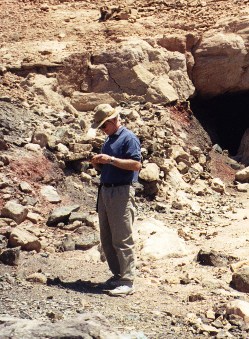
John Powell* outlines research carried out through the BGS Stratigraphy Committee, and collaboration with the Geological Society Stratigraphy Commission**
Geoscientist 18.10 November 2008
Peter Gutteridge’s recent Soapbox article (Geoscientist 18.3) prompted lively debate in the Letters page about the usefulness (or otherwise) of lithostratigraphy. My view is that geoscientists should make full use of all varieties of stratigraphy (lithostratigraphy ; sequence stratigraphy; biostratigraphy; chronostratigraphy; seismic stratigraphy; magnetostratigraphy; isotope stratigraphy etc.). All have their place, often depending on scale, and the availability of data.
For practical geologists these tools all relate back to a rock record that is most readily defined by a lithostratigraphical framework. It is the powerful combination of these forms of stratigraphy that advances our science and allows us to communicate our ideas and research. In this brief article I highlight the some of the work of the British Geological Survey (BGS) in the field of lithostratigraphy, and the important collaborative links with the Geological Society’s Stratigraphy Commission.
A tale of two Peters
Peter Allen (formerly Assistant Director, BGS) and Peter Rawson (Emeritus Professor, UCL) initiated the links between the long-standing GSL Stratigraphy Commission and the BGS Stratigraphy Committee in 1992. They realised that this branch of our science could only move forward if there was close collaboration between Survey geologists, who use lithostratigraphy as a fundamental mapping/modelling tool, and academia/industry, as represented by the Commission. An important factor in the success of this initiative was the attendance of the two Peters (and now the current Chairs) at meetings of the BGS Stratigraphy Committee and GSL Stratigraphy Commission.
In the 1990s BGS was moving quickly into the digital era of geological maps/models and their underpinning digital data-sets, which required scientific standards and dictionaries to operate effectively. This helped stimulate recognition of the need to rationalise the plethora of local lithostratigraphical names for UK geological units that had evolved since William Smith’s time through both academic research and geological surveys of often disparate 1:50k-scale sheets.
Rationalisation
The way forward was to rationalise lithostratigraphy by reducing local terms, where appropriate, and to encouraging a basin- or terrane-wide approach. And so, the BGS Stratigraphical Framework Reports were born. These research reports were initiated in geographical areas and parts of the column where BGS had (or has) recent expertise and, importantly, as a means of capturing information from knowledgeable staff. Furthermore, peer-review of the Stratigraphical Framework Reports by non-BGS staff (via the Commission) and also by members of the Commission was essential to their adoption. In some cases, non-BGS staff have contributed to the framework reports (e.g. Bernard Besly, Upper Carboniferous Red Beds of the Pennine Basin; Peter Rawson, Lower Cretaceous). This relationship continues today, and, to date, has spawned 11 stratigraphical framework reports that are available as BGS/GSL publications in the form of
free downloads.
Reports currently available include: the Chalk Group, UK Carboniferous Frameworks, Lower Cretaceous, Mercia Mudstone, Devonian (Old Red Sandstone) rocks of Scotland, Lower Jurassic of England and Wales, Westphalian to Early Permian red beds of the Pennine Basin, Carboniferous rocks of the Midland Valley of Scotland, Lake District volcanic and intrusive rocks, Quaternary and Neogene deposits of Great Britain and the Ordovician of Snowdonia and the Lleyn Peninsula. Several more are in preparation or final stages of review.
What’s in a name?
The framework reports are, themselves, linked to and underpinned by, the BGS Stratigraphical Lexicon
www.bgs.ac.uk/Lexicon/, which holds definitions for lithostratigraphical units (lithology; type section; age; boundaries; parent /child relationships etc.). It is a massive task to complete this online database for all UK units at the full definition level; but BGS is dedicating resources to ensure the Lexicon is kept up-to-date as a resource available to geoscience. Please be patient - we still have 2600 full definitions to complete!
BGS/GSL collaboration
BGS/GSL collaboration has fostered a number of initiatives, such as the GSL Professional Handbook, Stratigraphical Procedure (Rawson et al., 2002); the BGS Stratigraphical Chart (Waters et al., 2008 - featured recently in
Geoscientist v.18, 3); GSL Correlation Special Reports. In recent years the Commission, under Dr Jan Zalasiewicz, has published a number of papers on all matters stratigraphical, such as the recent GSA publication Are we now living in the Anthropocene?. Recent developments include a new lithodemic scheme for igneous rocks and tectono-metamorphic units; the UK Quaternary offshore stratigraphical framework, and a user-friendly, on-screen data entry format for the Lexicon. A digital version of the UK Stratigraphical Chart could become the interface to a much wider inventory of knowledge on UK rock units, such as physical properties, depositional environments or resource value.
With increasing pressure on the Earth’s resources and on our fragile environment, stratigraphy, once seen as ‘dull but worthy’ (it certainly was when I was at university), is entering an exciting and important new stage (or is that epoch…?).
* BGS Chief Geologist, England; Chair BGS Stratigraphy Committee
[email protected]
** Jan Zalasiewicz#, Tiffany L Barry, Paul R Bown, Patrick Brenchley, Angela L Coe, John C W Cope, Andrew Gale#, Philip Gibbard, John Gregory, Mark Hounslow, Andrew Kerr, Robert Knox, John Marshall, Michael Oates, Paul Pearson, John Powell, Peter Rawson, Alan Smith, Philip Stone, Colin Waters+, Mark Williams.
#Andy Gale has recently taken over the position of Chair from Jan.
+ Colin Waters is Secretary of the GSL Stratigraphy Commission; [email protected]
References
- Powell, J H, Chisholm, J I, Bridge, D McC, Rees, J G, Glover, B W, and Besly, B M 2000. Stratigraphical framework for the Westphalian to Early Permian red-bed successions of the Pennine Basin. British Geological Survey, Research Report, No. RR/00/01.
- Rawson, PF, Allen, PM, Brenchley, PJ, Cope, JCW, Gale, AS, Evans, JA, Gibbard, PL, Gregory, FJ, Hailwood, EA, Hesselbo, SP, Knox, RWO’B, Marshall, JEA, Oates, M, Riley, NJ, Smith, AG, Trewin, N &Zalasiewcz, JA 2002. Stratigraphical Procedure. Geological Society, London, Professional Handbook.
- Waters C N et al., 2008. Compiler. Stratigraphical Chart of the UK, Northern Britain and Southern Britain. British Geological Survey, Keyworth, Nottingham.